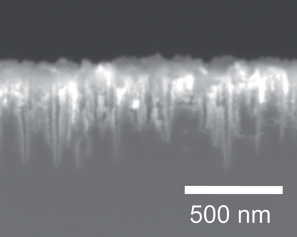 Nanoporous black silicon photocathode for H2 production by photoelectrochemical water splitting
Nanoporous black silicon photocathode for H2 production by photoelectrochemical water splitting
Jihun Oh, Todd G. Deutsch, Hao-Chih Yuan and Howard M. Branz
Energy and Environmental Science, 2011, C1EE01124C
Water splitting, a technique whereby hydrogen is extracted from water, could be a potential revolution in the direct conversion of solar energy into clean and storable fuel. Even though the photoelectrochemical (PEC) splitting of water at a semiconductor/electrolyte interface has drawn much attention as a viable method to produce H2, there have been some major limitations impeding the progress of this technology. However, scientists from the USA have developed a nanoporous black silicon photocathode which dramatically improves H2 production in such a system.
Although silicon, as an abundant and well-used semiconductor, is promising for use as the photocathode in a PEC system, it has an inherent drawback in its planar ‘wafer’ form. Around 25% of incident photons are reflected away from its planar surface, which means it does not make full use of the solar energy that falls upon it. Jihun Oh and coworkers at the National Renewable Energy Laboratory, Colorado, have tackled this issue by creating a nanostructured silicon photocathode which exhibits less than 5% reflectance due to the unique optical properties of the nanoporous surface. In addition to its impressive anti-reflective performance, the nanostructured photocathode also improves H2 production efficiency and should improve corrosion resistance.
This work provides an excellent example of how manipulation of the nanostructure of a semiconductor surface can improve its performance as a photocathode, and will hopefully guide future researchers in the design of advanced PEC systems.
To read the full article, click here.










